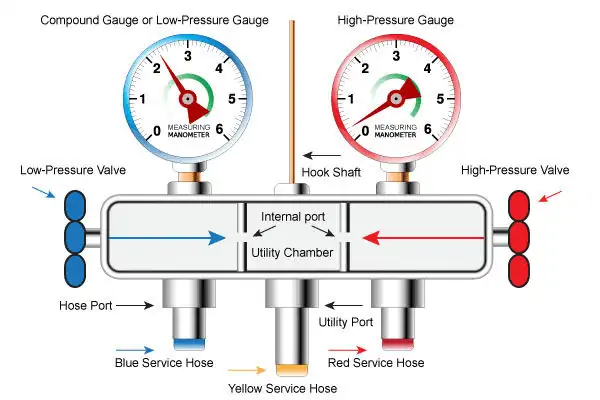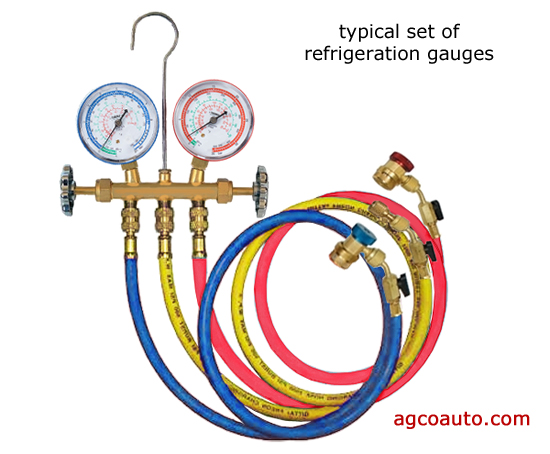How To Read Gauges For Air Conditioning

Understanding your air conditioning system is key to optimizing its performance, lowering energy bills, and extending its lifespan. One of the most valuable diagnostic skills for any homeowner or HVAC professional is the ability to read AC gauges. Properly interpreting these readings allows you to identify potential problems early, prevent costly repairs, and ensure your system is running efficiently. This article will guide you through the process, empowering you to understand your AC system's health.
Understanding AC Gauges: A Quick Overview
AC gauges, also known as manifold gauges, are essential tools for evaluating the performance of your air conditioning system. They measure the pressure of the refrigerant within the system, providing insights into its overall health. Typically, a manifold gauge set includes two gauges: a high-pressure gauge (usually red) and a low-pressure gauge (usually blue). These gauges are connected to the system via hoses, and a third hose (often yellow) is used for charging or evacuating refrigerant.
Essential Components of an AC Gauge Set
- High-Pressure Gauge (Red): Measures the pressure on the high-pressure side of the system, typically the discharge line of the compressor.
- Low-Pressure Gauge (Blue): Measures the pressure on the low-pressure side, usually the suction line of the compressor.
- Manifold: The central block connecting the gauges and hoses, allowing for control of refrigerant flow.
- Hoses: Color-coded hoses connect the gauges to the service ports on your AC unit.
- Service Ports: Access points on the AC unit where the gauges connect.
Before diving into the reading process, it’s crucial to understand the different types of refrigerant used in AC systems. Common refrigerants include R-22 (being phased out), R-410A, and R-32. Always consult your system's documentation or the unit itself to identify the type of refrigerant used. Using the wrong gauges or refrigerant can damage your system and potentially lead to environmental hazards.
Step-by-Step Guide to Reading AC Gauges
Safety First: Before working on your AC system, always disconnect the power at the breaker. Wear safety glasses and gloves to protect yourself from refrigerant and potential hazards. If you are not comfortable working with refrigerants, consult a qualified HVAC technician.
- Prepare the System: Ensure the AC system is running and has been running for at least 15 minutes to stabilize the pressures. Close all windows and doors to simulate normal operating conditions.
- Connect the Gauges: Identify the service ports on your AC unit. These are typically located near the compressor. Connect the blue hose to the low-pressure service port and the red hose to the high-pressure service port. Ensure the connections are secure and tight to prevent refrigerant leaks.
- Read the Gauges: Observe the readings on both gauges. Note the pressure readings in PSI (pounds per square inch).
- Compare to Specifications: Refer to the manufacturer's specifications for your AC unit to determine the ideal pressure ranges for both the high and low sides. These specifications are usually found on a sticker on the unit itself or in the owner's manual.
- Analyze the Readings: Compare the gauge readings to the manufacturer's specifications to identify potential issues.
Interpreting the Gauge Readings: Troubleshooting Common Issues
The real value of reading AC gauges lies in the ability to interpret the data and diagnose potential problems. Here's a breakdown of common issues and their corresponding gauge readings:
Low Refrigerant Charge
Symptoms: Low readings on both the high and low-pressure gauges.
Explanation: A low refrigerant charge is one of the most common AC problems. It indicates that the system is leaking refrigerant, reducing its cooling capacity. This issue often leads to increased energy consumption as the system struggles to maintain the desired temperature.
Energy Savings Impact: Addressing a refrigerant leak and recharging the system can improve energy efficiency by 20-30%, according to the Energy Star program.
High Refrigerant Charge
Symptoms: High readings on both the high and low-pressure gauges.
Explanation: An overcharged system can occur if too much refrigerant was added during a previous service. This can lead to increased pressure, strain on the compressor, and reduced cooling performance. It also increases the risk of compressor failure.
Clogged Filter Drier
Symptoms: Low reading on the high-pressure gauge and normal to low reading on the low-pressure gauge.
Explanation: The filter drier removes moisture and contaminants from the refrigerant. A clogged filter drier restricts refrigerant flow, causing a pressure drop.
Compressor Issues
Symptoms: Erratic or abnormal readings on both gauges.
Explanation: A failing compressor can exhibit various symptoms, including inconsistent pressure readings, unusual noises, and reduced cooling capacity. Compressor replacement can be a significant expense, highlighting the importance of regular maintenance to prevent failure.
Non-Condensables in the System
Symptoms: Higher than normal high-side pressure.
Explanation: Air or other non-condensable gases in the system will elevate the high-side pressure, reducing efficiency and potentially damaging the compressor.
The Role of Superheat and Subcooling
While gauge readings provide a general overview of system performance, calculating superheat and subcooling offers a more precise diagnostic approach. These calculations help determine whether the system is properly charged and operating efficiently.
Superheat
Superheat is the temperature of the refrigerant vapor above its saturation temperature at a given pressure. It's measured on the low-pressure side of the system and indicates how well the evaporator is functioning. Low superheat can indicate overcharging, while high superheat suggests undercharging.
Subcooling
Subcooling is the temperature of the refrigerant liquid below its saturation temperature at a given pressure. It's measured on the high-pressure side of the system and indicates how well the condenser is functioning. Low subcooling can indicate undercharging, while high subcooling suggests overcharging or a restriction in the liquid line.
Calculating superheat and subcooling requires additional tools, such as a thermometer or temperature probe, and a pressure-temperature (PT) chart for the specific refrigerant used in your system. The calculations involve comparing the measured temperature to the saturation temperature corresponding to the pressure reading on the gauges.
Smart HVAC Integration for Enhanced Monitoring and Efficiency
Integrating your HVAC system with smart home technology can provide even greater insight into its performance and efficiency. Smart thermostats, sensors, and energy monitoring systems can track key parameters like temperature, humidity, and energy consumption in real-time. This data can be used to optimize system settings, identify potential problems early, and reduce energy waste.
Benefits of Smart HVAC Integration
- Remote Monitoring: Access system data and control settings from anywhere via a smartphone or tablet.
- Automated Adjustments: Smart thermostats can automatically adjust temperature settings based on occupancy, weather conditions, and personal preferences.
- Energy Consumption Tracking: Monitor energy usage and identify opportunities for savings.
- Alerts and Notifications: Receive alerts when the system detects a problem or deviates from optimal performance.
For example, some smart thermostats can integrate with energy monitoring platforms to provide detailed reports on HVAC energy consumption, allowing you to identify and address inefficiencies. Additionally, smart sensors can detect refrigerant leaks early, minimizing environmental impact and preventing costly repairs. This integration not only provides convenience but also contributes to significant energy savings and improved system longevity.
Energy Savings, ROI, and Rebates
Investing in a properly functioning and efficient AC system can yield significant energy savings and a positive return on investment (ROI). According to the American Council for an Energy-Efficient Economy (ACEEE), upgrading to a high-efficiency AC system can reduce energy consumption by 20-40% compared to older, less efficient models.
Calculating ROI
To calculate the ROI of an AC upgrade, consider the following factors:
- Initial Cost: The cost of the new AC system, including installation.
- Energy Savings: The annual reduction in energy costs resulting from the upgrade.
- Maintenance Costs: Any changes in maintenance costs associated with the new system.
- Lifespan: The expected lifespan of the new AC system.
The ROI can be calculated by dividing the total energy savings over the lifespan of the system by the initial cost. For example, if a new AC system costs $5,000 and saves $500 per year in energy costs, the simple payback period would be 10 years.
Available Rebates and Incentives
Many utility companies and government agencies offer rebates and incentives for upgrading to energy-efficient AC systems. These programs can significantly reduce the upfront cost of the upgrade, making it even more attractive. Check with your local utility company and state energy office to learn about available programs.
For example, the federal government offers tax credits for energy-efficient home improvements, including HVAC upgrades. These credits can provide significant savings, further improving the ROI of your investment.
Conclusion
Reading AC gauges is a valuable skill that empowers you to monitor and maintain your air conditioning system's performance. By understanding the readings and identifying potential problems early, you can prevent costly repairs, improve energy efficiency, and extend the lifespan of your equipment. Furthermore, integrating smart HVAC technology can provide even greater insight into your system's performance, allowing you to optimize settings and reduce energy waste. With a little knowledge and effort, you can ensure your AC system is running efficiently and effectively for years to come.










